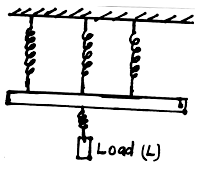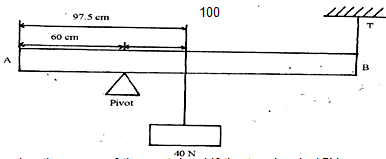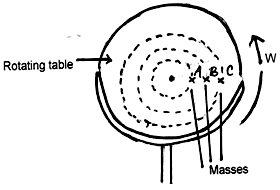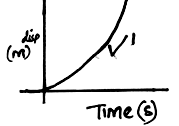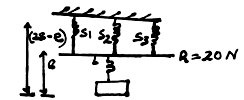INSTRUCTIONS TO CANDIDATES:
- This paper consists two sections A and B.
- Answer all questions in Section A and B in the spaces provided.
- All working MUST be clearly shown.
- Mathematical tables and electronic calculators may be used.
SECTION A (25 MARKS)
Answer ALL questions in this section in the spaces provided
- The figure below shows a micrometer screw gauge that has a zero error of +0.02. State the actual reading
of the micrometer screw gauge. (1mk) - In the figure below, the U-tube contains two immiscible liquids P and Q. If the density of Q is 900kg/m3 and that of P is 1200kg/m3 , calculate the height of liquid Q. (3mks)
- A body is acted upon by a force of I0N towards the right hand side and 6N towards the left hand side.
What is the resultant force? (2mks) - The difference between the ice point and steam point on a liquid thermometer is 30cm. What temperature is recorded when the mercury thread is 12cm. (2mks)
- Water flows through a horizontal pipe of cross-sectional area of 40cm2 . If the speed at the constriction is 4ms-1 , calculate the mass flux (density of water = 1000kg/m3) (3mks)
- In terms of intermolecular forces, explain the difference between liquid and gaseous state. (2mks)
- The diagram below shows two similar cups of tea containing equal volumes of hot tea at the same level. It was observed that the rate of cooling was the same in the two cups. Explain. (2mks)
- The figure below shows a vessel resting on a horizontal bench.
State and explain the effect on the stability of the vessel when it is filled with water. (2mks) - What does it mean to say the density of water is 1g/cm3 ? (1mk)
- State any two possible ways of increasing velocity ratio of wheel and axle. (2mks)
-
- Under what conditions can a feather and a stone released from the same height land on the ground at the same time? (1mk)
- On the axis below, sketch displacement time graph for an accelerating body. (1mk)
- The figure below shows four equivalent springs with negligible weight, the weight of the rod R is 20N. Given that the spring constant is 5N/m. Calculate the load L which causes an extension of 28m to the system. (3mks)
SECTION B (55 MARKS)
Answer ALL questions in this section in the spaces provided
- A stone thrown vertically upwards from the base of a mountain with an initial velocity of 100m/s. The stone just stopped as the apex and came back. Another boy projected a stone horizontally from the top of the mountain. Calculate:-
- Height of the mountain. (2mks)
- Time taken for the stone to follow the trajectory. (2mks)
- The range if the horizontal velocity is 20m/s, (2mks)
- Calculate the impulse of force produced when a table is pulled for 3s by a constant force of 10N towards the right and then for 2s by a constant force of 20N towards the left. (2mks)
- The figure below shows a tape from a trolley accelerating at 5m/s2 and the timer is vibrating at 100Hz.
Calculate:- Change in velocity from A to B. (2mks)
- The final velocity of the trolley. (2mks)
-
- Two gear-wheels have 80 teeth and 20 teeth and they lock with each other. They are fastened on axles of equal diameter such that equal weight of 150N attached to the string around the axle will just raise 450N on the other axles.
Calculate:- The mechanical advantage. (2mks)
- The velocity ratio. (2mks)
- The efficiency of this machine. (2mks)
-
- A Loudspeaker is a transducer. Explain. (1mk)
- Explain the energy change that occur when a man climbs the mountain. (1mk)
- Calculate the total power in lifting 0.2kg of metal cane containing 2000cm3 of ice onto a lorry as shown below within 4s. The density of ice = 0.9g/cm3 ) (3mks)
- Two gear-wheels have 80 teeth and 20 teeth and they lock with each other. They are fastened on axles of equal diameter such that equal weight of 150N attached to the string around the axle will just raise 450N on the other axles.
-
- What is meant by specific latent heat of Vaporization? (1mk)
- In an experiment to determine the specific latent heat of vaporization of water, steam at 100 0 C was passed into water contained in a well lagged copper calorimeter.
The following measurements were made:-
Mass of calorimeter = 50g
Initial mass of water = 70g
Initial temperature of water = 5°C
Final mass of water + Calorimeter + condensed steam = 123g
Final temperature of mixture = 30°C
Specific heat capacity of water = 4200JKg-1k-1
Specific heat capacity of copper = 390 JKg-1k-1- Determine the:-
- Mass of condensed steam (2mks)
- Heat gained by water and calorimeter. (2mks)
- Given that L is the specific latent of heat of vaporization of steam:
- Write an expression for the heat given out by steam. (1mk)
- Determine the value of L. (2mks)
- Determine the:-
- The pressure P1 of a fixed mass of gas at constant temperature, T = 300K is varied continuously as depicted in the graph below.
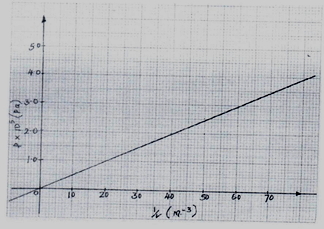
From the graph:- Determine the volume of the gas when the pressure read 2.5 x 10 5 Pa. (2mks)
- Given that pV = 2RT where R is a constant, use the graph to determine R. (2mks)
-
- State the law of floatation. (1mk)
- A block of wood of mass 80kg floats in water with 0.6 of its volume in water. Calculate the number of rods each 20g that can be placed on the block so that its top is level with the surface of water. (4mks)
- The diagram in figure 9 below shows a wooden block of dimensions 50cm by 40cm by 20cm held in position by a string attached to the bottom of a swimming pool. The density of the block is 600kgm-3.
- State the three forces acting on the block and write an equation linking them when the block is stationary. (2mks)
- Calculate the tension on the string. (3mks)
- The figure below shows a metal rod AB of length 2m horizontally balanced while supported by a pivot and a string.
Determine the mass of the metal rod if the tension is 15N. (3mks)
-
- The figure below shows asses A, B and C placed at different points on a rotating table.
The angular velocity W, of the table can be varied
- State two factors that determine whether a particular mass slides off the table or not. (2mks)
- It is found that the masses slide off at angular velocities WA , WB and WC respectively. Arrange the values of WA , WB and WC in decreasing order. (1mk)
- A block of mass 200g is placed on a frictionless rotating table while fixed to the centre of the table by a thin thread. The distance from the centre of the table to the block is 15cm. If the maximum tension the thread can withstand is 5.6N, determine the maximum angular velocity the table can attain before the thread cuts.
- The figure below shows asses A, B and C placed at different points on a rotating table.
MARKING SCHEME
- Actual reading = (6.20 – 0.02)mm
= 6.18mm ✓1 - h1 ℓ1 g = h2p2g ✓1
h x 900 = 0.06 x 1200 ✓1
h = 0.08m = 8cm ✓1 - 4N
✓1
Resultant force ✓1 = (10 – 6)N = 4N ✓1 towards the ✓1 right hand side. - ℓ100 – ℓ0 = 30cm
Ф = ℓ0 – ℓ0 = 12
100 ℓ100 – ℓ0 30
Ф = 12 x 100°C ✓1 = 40°C ✓1
30 - Mass flux = density x volume flux ✓1
= 1000 x 160 x 10-6
= 0.16kgs-1 - In liquids the forces are smaller and molecules are able to roll✓1 over one another while in the gaseous state, the molecules are free to move because gases have the weakest force✓1 of attraction.
- A✓1 – loses heat through evaporation because of large surface area and B✓1 – because dull surface is a good emitter of heat. ✓1
- Lowered✓1
As the water fills the vessel the centre of gravity rises and this lowers stability. ✓1 - It means a cubid centimeter of water has a mass of 1g. ✓1
- V.R. = R (Radius of the wheel)
r (radius of the axle- Increase the radius of wheel (R
- Reduce the radius of the axle (r)
-
- in a vacuum
-
-
Combined spring constant S1, S2, S3 = 3 x 5N/m
= 15N/m
e = F
K
(28 – e) = (L + 20)
15
420 – 15e = L + 20
400 = L + 15e … (i)
e = L/K
e = L/5
5e = L … (ii)
simultaneously (i) and (ii)
e = 400
20
= 20m
Therefore L = 5 x 20
= 100N ✓1
OR
S1, S2, S3
L + 20
3
5N = 1m
L + 20 = ?
3
(L + 20) ✓1
5N = 1m
L = ?
L/5 ✓1
Therefore L + 20 + L = 28
15 5
L + 20 + 3L = 420
4L = 400
L = 100✓1 -
- Vertical projection U = 100m/s g = −10m/s v = om/s
V2 = u2 – 2gs ✓1
O2= (100)2 – 2 x 10 x 5
20s = 10,000
s = 500m ✓1 - Horizontal projection h = ½ gt2 ✓1
500 = ½ x 10 x t2
t2 = 100
t = 10s ✓1 - Range R = ut ✓1
R = 20 x 10
= 200m✓1 - Impulse = change in momentum ✓1
Ft = (10N x 35)✓1 – (20N x 25)
= −10NS ✓1 -
- v – u = a
t
t = (5 ticks x 0.01)s
= 0.05s ✓1
Therefore Δv = 5cm/s2
0.05
Δv = 0.25cm/s ✓1 - v – u = 0.25cm/s
u = 0.125cm
0.01
= 12.5cm/s✓1
V – 12.5 = 0.25
V = 12.75cm/s✓1
- v – u = a
- Vertical projection U = 100m/s g = −10m/s v = om/s
-
-
- M.A = L/E
= 450N ✓1
150N
= 3 ✓1 - V.R = No. of teeth on driven gear
No. of teeth on driving gear
= 80 ✓1
20
= 4 - ŋ = m.A x 100%
V.R
= ¾ x 100%
= 75%
- M.A = L/E
-
- Converts electrical energy – sound energy. ✓1
- Chemical Kinetic Potential
- Mass of ice = 0.9g/cm3 x 2000cm3
=1800g
= 1.8kg
+0.2
2.0kg ✓1
w = Fxd
= 20N x 5M
= 100J ✓1
Power = Work done
Time
= 100J
4S
= 25J/S or 25 watts ✓1
-
- Quantity of heat required to convert a unit mass of liquid to vapour at constant temperature. ✓ (2mks)
-
-
- Mass of condensed steam = 123 – (70 + 50) (1mk)
= 123 – 120 = 3g (1mk) - Heat gained by water = MCΔQ
= 0.07 x 4200 x 25 = 7350J
Heat gained by cal = 50 x 390 x 25 = 487.5J
1000 (1mk)
Total heat gained = 487.5 + 7350 = 7837.5J (1mk)
- Mass of condensed steam = 123 – (70 + 50) (1mk)
-
- Heat lost by steam = ml + MCΔE
= 0.003l + (0.003 x 4200 x 70) = 7837.5J
0.003L = 6955.5 - L = 6955.5
0.003
= 2318500J
- Heat lost by steam = ml + MCΔE
-
-
- At P = 2.5 x 105Pa, I/V = 50m−3(read from graph)
Therefore V = 1/50 = 0.02m3 ✓1 - Gradient = 2RT grad = 3 – 2 = 1 = 0.05
60 – 40 20
R = gradient
2T
R = 0.05 = 8.3 x 105N m/k or JK-1 ✓1
2 x 300
- At P = 2.5 x 105Pa, I/V = 50m−3(read from graph)
-
- Floating object displaces its own weight of the fluid in which it floats
- Mass of water displaced by wood = 80kg
Volume of water displaced = 80 = 0.08m3
1000
but 0.08m3 = 0.6 of the volume of block.
→ Volume of wood = 0.08 = 0.1333m3;
0.6
Volume displaced by rods = 0.08 – 0.1333 = 0.0533
Mass of he rods = 0.053 x 1000 = 53.3kg;
Mass of one rod = 20g = 0.02kg
Number of rods = 53.3;
0.02
= 2,665 rods; -
-
- Up thrust force
- Weight ✓✓Max. 2 or 3;;
- Tension on the string 1
Up thrust = weight + tension on the string;
- Up thrust = weight + tension
(50 x 40 x 20) 1000 x 10 = 50 x 40 x 20 x 6000 + tension;;
1000000 100000
Tension = 200 – 240
=−40N
-
- Sum of clockwise Moments = Anti clockwise Moments✓1
37.5 x 40 + W x 40 = 140 x 15
1500 + 40W = 2100
40W = 2100 – 1500
40W = 600
W = 6N✓1
W = 15N
M = 1.5Kg or 1500g
-
-
- Roughness✓ / smoothness✓ of surface / radius of path / angular velocity /speed. (any two)
- WA > WB > WC ✓1
- F = MV2
r
5.6 = 0.2 × V2
0.15 ✓
V2 = 5.6 × 0.15
0.2
V2 = 4.2
V = 2.049 m/s ✓
V = rW
W = V
r
= 2.049 ✓
0.15
= 13.66rad/s ✓
-
Download Physics Paper 1 Questions and Answers - Nyeri Mocks 2021 Exams.
Tap Here to Download for 50/-
Get on WhatsApp for 50/-
Why download?
- ✔ To read offline at any time.
- ✔ To Print at your convenience
- ✔ Share Easily with Friends / Students






